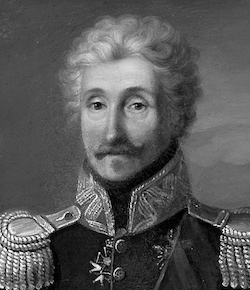General Józef Zajączek

Born: November 1, 1752
Place of Birth: Kaminietz, Poland
Died: July 21, 1826
Place of Death: Warsaw, Poland
Arc de Triomphe: ZAYONSCHECK on the south pillar
Pronunciation:
Born in Poland, Józef Zajączek's name is frequently spelled Zayonchek or Zayonczek in English and French sources. He began his military career in 1768 in Poland and he served against the Bar Confederation. In 1774 Zayonchek was promoted to captain in the Dragoons of Bulawa and he became an aide-de-camp to Branicki. The next year he became a sous-lieutenant in the French regiment of Bercheny Hussars, but he returned to Poland not long thereafter. In 1785 Zayonchek became lieutenant colonel of the Polish regiment of Bulawa and the following year he became colonel of the regiment. In 1788 he served with Russian forces at the siege of Ochakov.
In 1792 Zayonchek served as a lieutenant général under Poniatowski against the Russians, and then in 1794 during the Kosciuszko Uprising he was wounded by two shots in the defense of Praga. The next year Zayonchek was arrested in Galicia by the Austrians, but he managed to escape and make his way to freedom in France. In March of 1797 General Bonaparte admitted Zayonchek into the service of France as a général de brigade in the Army of Italy and then gave him command of a corps of cavalry. In the following months General Zayonchek raised a battalion of 1000 Polish soldiers to serve with the army.
Designated for the Army of the Orient, Zayonchek initially commanded cavalry in Egypt before being placed under Andreossy's command with the flotilla of the Nile. While in Egypt, soldiers began to call him "General Watermelon" due to his love of the fruit. After fighting at Chebreiss, Zayonchek was made governor of the province of Menoufia, and then he fought at Remerieh. Next he served under Desaix and then in 1799 he was given command of the provinces of Beni Souef and Fayoum. In 1800 Zayonchek became commander of Gizeh and in March of 1801 he fought at Canope . After he took part in the defense of Alexandria General Menou promoted him to général de division in May of 1801, and then Zayonchek returned to France at the end of the year.
For the remaining years of the Consulate Zayonchek served in Italy commanding a division, and then in June of 1804 he received the honor of being made a Commander of the Legion of Honor. In September of 1805 he joined the staff of the Grande Armée under Andreossy and he served during the campaign of that year until he became sick in Vienna. In September of 1806 he was ordered to organize a Polish legion and upon doing this he took command of this new unit. After traveling to Warsaw in December, the following month he was placed in charge of a Polish corps with which he besieged Graudenz. With the signing of the Treaty of Tilsit in July of 1807 and the creation of the Grand Duchy of Warsaw, Zayonchek passed into the service of the duchy.
Over the next few years, Zayonchek commanded a division under Poniatowski and he participated in Poland during the war of 1809 against Austria. In 1810 he took command of the 1st military division of Warsaw. For the Russian campaign of 1812, Zayonchek commanded the 16th Division of Poniatowski's V Corps and he was wounded leading his division at Smolensk . During the retreat, when Poniatowski was wounded at the Battle of the Berezina, Zayonchek took command of the corps and led it until being wounded in the leg by a ball. Despite being a potentially fatal wound, Dr. Larrey saved his life by performing a difficult amputation of his leg in deplorable conditions. As the snow fell and the wind blew, Larrey ordered some soldiers to hold a cloak above them as a makeshift tent while he performed the amputation, which took only three minutes. Sent to Vilna in Larrey's personal carriage to recover, Zayonchek survived but was taken prisoner and held until 1814. So thankful for surviving his awful wound, Zayonchek wrote to Larrey, hoping to repay him by returning his carriage or paying him for his service. Dr. Larrey wrote him back, but did not hear from him or receive his carriage. Finally in 1819, Zayonchek sent money and a letter to Larrey that ended with, "I embrace you and thank you from the bottom of my heart."1
Notes
- Robert Richardson, Larrey: Surgeon to Napoleon's Imperial Guard, (London: Quiller Press, 2000), 180-181.
Bibliography
- Divry, Arnauld. Les Noms Gravés sur l'Arc de Triomphe. Paris: L'Harmattan, 2017.
- Nafziger, George, Mariusz T. Wesolowski, and Tom Devoe. The Poles and Saxons During the Napoleonic Wars. Chicago: Emperor's Press, 1991.
- Six, Georges. Dictionnaire Biographique des Généraux & Amiraux Français de la Révolution et de l'Empire (1792-1814). 2 vols. Paris: Gaston Saffroy, 2003.
Updated December 2024
© Nathan D. Jensen